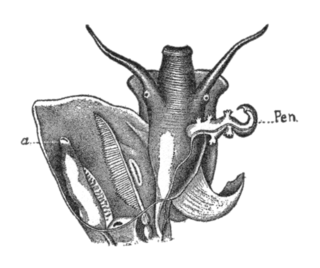
The French Southern and Antarctic Lands is an Overseas Territory of France. It consists of:
- Adélie Land, the French claim on the continent of Antarctica.
- Crozet Islands, a group in the southern Indian Ocean, south of Madagascar.
- Kerguelen Islands, a group of volcanic islands in the southern Indian Ocean, southeast of Africa.
- Saint Paul and Amsterdam Islands, a group to the north of the Kerguelen Islands.
- The Scattered Islands, a dispersed group of islands around the coast of Madagascar.

The Adélie penguin is a species of penguin common along the entire coast of the Antarctic continent, which is the only place where it is found. It is the most widespread penguin species, and, along with the emperor penguin, is the most southerly distributed of all penguins. It is named after Adélie Land, in turn named for Adèle Dumont d'Urville, who was married to French explorer Jules Dumont d'Urville, who first discovered this penguin in 1840. Adélie penguins obtain their food by both predation and foraging, with a diet of mainly krill and fish.

Volutidae, common name volutes, are a taxonomic family of predatory sea snails that range in size from 9 mm to over 500 mm. They are marine gastropod mollusks. Most of the species have no operculum.

Littoridina is a genus of small freshwater snails with a gill and an operculum, aquatic gastropod mollusks in the family Cochliopidae.

Littorina saxatilis, common name the rough periwinkle, is a species of small sea snail, a marine gastropod mollusc in the family Littorinidae, the winkles or periwinkles. First identified in the 1700s, it has been misidentified as a new species 112 times.

Conus textile, the textile cone or the cloth of gold cone is a venomous species of sea snail, a marine gastropod mollusk in the family Conidae, the cone snails, cone shells or cones. Textile cone snails live mostly in the Indian Ocean, along the eastern coast of Africa and around Australia.
Heleobia is a genus of small freshwater and brackish water snails with a gill and an operculum, aquatic gastropod mollusks in the family Cochliopidae and the superfamily Truncatelloidea.

Cirsonella is a genus of small sea snails, marine gastropod molluscs in the family Skeneidae.

Freshwater snails are gastropod mollusks which live in fresh water. There are many different families. They are found throughout the world in various habitats, ranging from ephemeral pools to the largest lakes, and from small seeps and springs to major rivers. The great majority of freshwater gastropods have a shell, with very few exceptions. Some groups of snails that live in freshwater respire using gills, whereas other groups need to reach the surface to breathe air. In addition, some are amphibious and have both gills and a lung. Most feed on algae, but many are detritivores and some are filter feeders.

Pleurotomella is a genus of sea snails, marine gastropod mollusks in the family Raphitomidae.

Granulifusus is a genus of sea snails, marine gastropod mollusks in the subfamily Fusininae of the family Fasciolariidae, the spindle snails, the tulip snails and their allies.

Xymenopsis buccineus is a species of sea snail, a marine gastropod mollusk in the family Muricidae, the murex snails or rock snails.
Xymenopsis corrugata is a species of sea snail, a marine gastropod mollusc in the family Muricidae, the murex snails or rock snails. They reproduce sexually.

Xymenopsis muriciformis is a species of sea snail, a marine gastropod mollusk in the family Muricidae, the murex snails or rock snails.
Xymenopsis subnodosus is a species of sea snail, a marine gastropod mollusk in the family Muricidae, the murex snails or rock snails.

Xymenopsis is a genus of sea snails, marine gastropod mollusks in the family Muricidae, the murex snails or rock snails.
Luc-Marie Bayle was a French naval officer, painter, and artist.

Terrestrial molluscs or land molluscs (mollusks) are an ecological group that includes all molluscs that live on land in contrast to freshwater and marine molluscs. They probably first occurred in the Carboniferous, arising from freshwater ones.

Notocrinus virilis is a marine invertebrate, a species of crinoid or feather star in the family Notocrinidae. It is found in deep water in the Southern Ocean around the coasts of Antarctica and adjacent islands. A sea snail sometimes parasitizes it.















